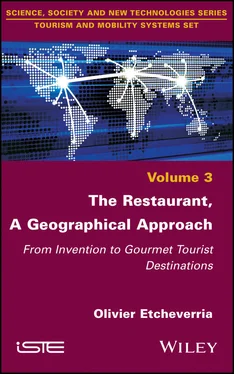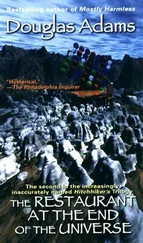Thus:
“After 1870, the ‘Alsatian brasserie’ appeared on the initiative of Alsatians who had withdrawn to Paris, serving both beer and Alsatian cuisine (sauerkraut, pork shanks, herring apples in oil, veal head, flambé pie, etc.). The brasserie is in fashion.” [BON 13, p. 292, author’s translation]
From the 1860s onwards, brasseries refined their decor ( Zimmer in 1862 on Place du Châtelet, Bofinger in 1864 on Place de la Bastille, Lipp in 1880 on Boulevard Saint-Germain, Mollard in 1895 on Rue Saint-Lazare). They thus became showcases of the decorative Art Nouveau and Art Deco style ( Le Vaudeville in 1918 on Place de la Bourse, La Coupole in 1927 on Boulevard du Montparnasse).
At the beginning of the 20th Century, restaurants serving regional and foreign cuisine developed, as in the Latin Quarter:
“In the heart of the district, in 1925, the Rôtisserie Périgourdine opened on Place Saint-Michel, under the direction of the Rouzier brothers, in the place of a grill room that has not left much trace in history. Here, regional cuisine was at the forefront, and that of a particularly rich province. What about the gratin périgourdin: minced fresh mushrooms, fresh cream and truffle strips, covered with a puff pastry and put in the oven… and the stuffed pike, and the hare in royal style, and the rooster in paste and truffles under ashes?…” [HER 56, p. 282, author’s translation]
The restaurant Méditerranée opened on Place de l’Odéon:
“It was fishing, Place de l’Odéon, which led to the Méditerranée , where Provençal cuisine was to find one of its great Parisian homes, the spiritual heirs of the Frères Provençaux , as later on the Relais de Porquerolles , rue de l’Éperon. In Méditerranée , decorated by Vertès in southern tones, grilled wolves with fennel, fried scampi in tartar sauce, crustaceans and bouillabaisse were appreciated by artists in writing or prestidigitation, with Cocteau and Picasso mainly. Following blackcurrant and rosé from the Var, the stuffed mussels looked as good as in Bandol or Cannes; it is one of the graces of our time to have been able to see Paris, the center of the globe, receive at home in the desired way so strange or so distant that it seemed.” [HER 56, p. 284, author’s translation]
Similarly, “Châtaignier, rue du Cherche-Midi, despite its very simple service, offered nothing to anyone, but its pike with white butter and nutmeg being better than in Nantes or Saint-Nazaire and the quality of all its dishes remaining perfect.” [HER 56, p. 284, author’s translation]
In 1932, Marthe Allard, a peasant woman from Burgundy, acquired a restaurant at the corner of rue Saint-André-des-Arts and rue de l’Éperon (see Figure 2.6). The chef mother and her daughter-in-law offered Burgundian cuisine dishes: frog legs, duck with olives and rooster in wine. The restaurant was a former wine merchant (the window grills preserved) transformed into a bistro La Halte de l’Éperon by Vincent Candré. Simple dishes were cooked by Josephine, “one of the first ‘Parisian cooking mothers’” 9 . From the 1930s until the end of the war, Allard remained a family-oriented neighborhood bistro. After the war, Allard forged a reputation that would be consolidated year after year. In 1946, Marthe and Marcel Allard’s son, André, married Fernande who continued to serve the dishes passed on by her mother-in-law. They were served with wines from Beaujolais and Burgundy. In July 2013, the restaurant was bought by Alain Ducasse: “Fernande Allard’s precious legacy will continue to inspire us. There is no question of touching the house’s DNA, we will simply make sure that it is part of its time.” The kitchen is still being prepared today by a woman, Pauline Berghonnier.

Figure 2.6. Restaurant Allard, located at 41, rue Saint-André-des-Arts (source: Olivier Etcheverria)
However, René Héron de Villefosse points out that: “This does not mean that between these two world wars the taste of foreign cuisine was not within reach of our jaws. You could go around the world in 12 restaurants…” [HER 56, p. 285, author’s translation]
Valérie Ortoli-Denoix points out: “Accessible to a large number of people financially and locally, Parisian restaurants are exploding in various directions. The most characteristic extension is to the south.” [ORT 90, p. 24, author’s translation] Especially in the western part of the left bank.
Jean-Robert Pitte therefore specifies that:
“Throughout the 20th Century, this distribution persisted. A diffusion is carried out even in the peripheral districts of the capital and the suburbs, but for nine-tenths of them, the establishments are all located west of a railway line from East Bastille to Porte d’Orléans.” [PIT 91, pp. 172–173]
Until the second half of the 19th Century, the restaurant remained an essentially Parisian place, becoming emblematic of the capital as Rebecca L. Spang points out:
“The restaurant had become a true cultural institution, among the most familiar and distinctive of Parisian landmarks. Until well after the middle of the 19th Century, restaurants were to remain an almost exclusively Parisian phenomenon, one rarely encountered outside the French capital.” [SPA 00, p. 2]
She specifies:
“For even by the middle of the 19th Century, restaurants were still an overwhelmingly urban phenomenon, inventions of the capital and icons of its pleasures. To be conversant with the protocols, rituals, and vocabulary of restaurant going was to be quintessentially Parisian and supremely sophisticated.” [SPA 00, p. 172]
So how did restaurants spread outside the capital?
1 1The Ancien Régime is a French term for the political and social system of France from the Late Middle Ages until 1789.
2 2 http://grand-vefour.com, accessed September 22, 2018.
3 3Ibid.
4 4Ibid.
5 5Ibid.
6 6Ibid.
7 7Book republished by Les éditions de l’Épure.
8 8See Jeanne Gaillard, Paris la ville, 1851–1870, Honoré Champion, Paris, 1976.
9 9 www.restaurant-allard.fr, accessed January 3, 2019.
3
The Geographical Diffusion of Restaurants in Provinces by Cities and City Networks
The geographical diffusion of restaurants in the provinces was slow and uneven. It passed through cities organized in networks:
“From the beginning, the most permanent role of a city has been to enhance a situation in a network. Centrality is nourished by the agglomerated power that converges exchanges and relations towards privileged centers: the polarization of the territory arises from this duality between the centers and their peripheries.” [PUM 89, p. 75, author’s translation]
City networks show a hierarchical organization that is expressed in regular arrangements according to the size of cities [PUM 89]. This model is formalized by the central place theory [PUM 89].
3.1. The geographical diffusion of restaurants in the provinces: an application of rank-size law…
In the provinces, restaurants spread geographically through the cities in a rather hierarchical way.
Overall, the first restaurants appeared in the old centers of the big cities. They were particularly well supplied with multimodal transport (intertwining of the different modes of transport) and a point of convergence of flows (intertwining of interrelationships).
In Bordeaux, for example, Philippe Meyzie, writing in the Journal de Guyenne , mentioned the existence of “restaurant tables” at 1784 rue Mautrec and 1785 place Saint-Rémi. He specifies that this was a complementary activity for café owners [MEY 07, p. 72]. He also mentions the creation of the Restaurant de la Poste at 1805 rue Porte-Dijeaux [MEY 07, p. 73]. However, Philippe Meyzie points out that the development of restaurants remained very limited during the first half of the 19th Century [MEY 07, p. 73]. In 1825, Le Chapon Fin opened on rue Montesquieu near the Théâtre-Français, “but it was not really successful until the second half of the 19th Century” [MEY 07, p. 73, author’s translation]. In 1901, Cyprien Alfred-Duprat created a decor of stony ground and caves and Joseph Sicart (former sauce chef at Café Anglais ) served a fine cuisine:
Читать дальше













